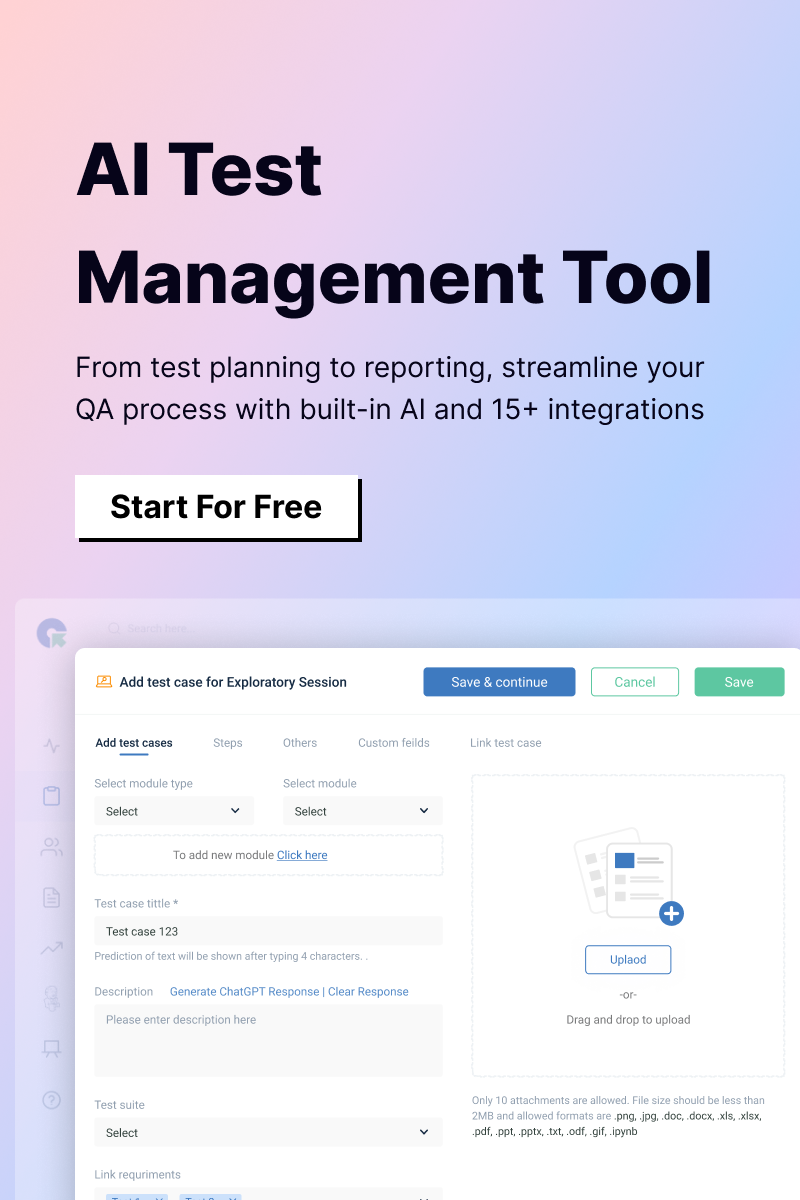Imagine a user installs your app on the latest iPhone, and it crashes. But on an older Android phone? It runs flawlessly. This might come as a nightmare for developers, highlighting the need for compatibility testing. As users access your product from different browsers, operating systems, devices, and networks, Compatibility Testing ensures your software performs seamlessly across this variety, so no user is left behind. In this blog, we will discuss compatibility testing using the forward and backward examples, its types, tools and more.
What Is Compatibility Testing?
Alt text: What is compatibility testing
Compatibility Testing is a type of non-functional testing that verifies whether an application performs as expected across a wide range of computing environments. The primary goal is to ensure a consistent and seamless user experience, regardless of the device, operating system, browser, hardware configuration, or network condition being used.
This testing evaluates the application’s adaptability to:
- Different hardware specifications (CPU, memory, graphics, etc.)
- Various operating system versions (Windows, macOS, Linux, iOS, Android)
- Multiple browsers (Chrome, Firefox, Safari, Edge, etc.)
- Databases and other third-party software dependencies
- Diverse devices (smartphones, tablets, desktops, etc.)
- Varying network conditions (Wi-Fi, 3G, 4G, 5G, low bandwidth)
A comprehensive compatibility testing process also includes evaluating:
- Forward Compatibility– Ensuring current software works with future environments
- Backward Compatibility– Ensuring new versions of software remain functional on older systems
Importance of Compatibility Testing
Alt text: Benefits of compatibility testing
In a world where users have endless choices of devices and platforms, compatibility testing is no longer optional; it’s essential. Here’s why:
- Applications must be accessible to users, regardless of the platform or device they use. Compatibility testing ensures broad accessibility by validating functionality across different environments.
- Incompatibility issues can lead to broken features, failed transactions, or application crashes on specific devices. These problems often result in lost customers and reduced revenue, especially in consumer-facing applications.
- When an application performs reliably across all platforms, it increases user satisfaction and strengthens brand credibility. A consistent experience builds trust and encourages continued engagement.
- Identifying and resolving compatibility issues before deployment helps reduce the risk of critical failures in production. This approach leads to smoother launches and lower support costs.
- Compatibility testing is crucial for web applications, cross-platform mobile apps, and Saas solutions that need to support a wide range of user configurations.
Types of Compatibility Testing
Alt text: Compatibility testing types
Compatibility Testing isn’t a one-size-fits-all approach. There are several types you should be aware of, each targeting a specific aspect of your application’s environment.
Browser Compatibility Testing
If you’re working on a web application, browser compatibility is critical. Different browsers, such as Chrome, Firefox, Safari, and Edge, interpret code in slightly different ways. Testing across these browsers helps ensure your layout, functionality, and styling remain consistent no matter where your users access your app.
Operating System Compatibility
Your users might be on Windows, macOS, Linux, iOS, or Android, and each OS handles applications differently. Testing across operating systems (and their various versions) helps ensure your app performs reliably and looks polished, regardless of the underlying system.
Device Compatibility
From smartphones and tablets to laptops and desktops, your users are on a wide range of devices with different screen sizes, resolutions, and hardware capabilities. Testing for device compatibility helps you catch UI or performance issues that may appear only on specific models or form factors.
Network Compatibility
Not all users enjoy high-speed connections. Some might be on 3G, others on 5G, or dealing with intermittent connectivity. Network compatibility testing allows you to simulate these conditions and ensure your app still functions correctly, even with slower or unstable networks.
Software/Library Compatibility
If your application integrates with third-party libraries, APIs, or plugins, you’ll want to make sure they all play nicely together. Testing across different versions of these dependencies ensures your app remains stable and secure, even as external tools evolve.
Hardware Compatibility
Users can run your software on a range of devices, from entry-level models with limited RAM and processing power to high-performance machines. Hardware compatibility testing helps you validate performance and usability across different configurations, so your app runs smoothly for everyone.
What Is Forward Compatibility Testing?
Forward compatibility means ensuring that the current version of the software can work well with future versions of hardware, software, or platforms, whenever possible- whether it’s a new OS, device, or other environment that emerges after your app is released.
Although it’s impossible to predict every change in future environments, forward compatibility can be achieved by designing your software with flexibility and adhering to industry standards. This helps the app adapt to upcoming updates, reducing the chances of breaking or requiring significant rework when the new systems are released.
Example:
Consider a mobile app built for Android 11. The goal of forward compatibility testing is to ensure that this app continues to work well when installed on Android 13 (assuming there are no major OS restrictions). This foresight ensures that your users don’t encounter issues with future updates, enhancing longevity and minimizing the need for immediate patches when new versions of the OS are released.
What Is Backward Compatibility Testing?
Backward Compatibility Testing ensures that the latest version of your software continues to function smoothly on older versions of systems, devices, or dependencies. This is especially crucial for users who haven’t upgraded their operating systems, devices, or software libraries.
Backward compatibility testing ensures that new updates don’t inadvertently break functionality for users who rely on older configurations. It’s particularly important for maintaining a broad user base and ensuring no one is left behind as your software evolves.
Example:
Imagine a video conferencing app that has been updated in 2025. With backward compatibility testing, you would verify that this updated app still works seamlessly on devices running iOS 15, even though iOS 15 was released back in 2021. This is critical to ensuring that users who haven’t upgraded to the latest version of iOS can still use your app without issues.
Forward vs Backward Compatibility: Key Differences
Forward compatibility is about anticipating future systems and ensuring that your software works well with them. In contrast, backward compatibility focuses on maintaining functionality for users with older systems, devices, or OS versions.
| Aspect | Forward Compatibility | Backward Compatibility |
| Focus | Ensures compatibility with future systems, devices, or platforms | Ensures compatibility with older systems, devices, or platforms |
| Goal | Prevents future incompatibility by designing for future environments | Preserves support for legacy environments, ensuring older users aren’t left behind |
| Challenge | Difficult to test since future systems and platforms are unknown | Easier to test, as the systems and platforms are already in place and known |
| Example | An app built for Android 11 should work on future versions like Android 13 | A new app version should work on older OS versions, like iOS 15 or Android 8 |
| Use Case | Future-proofing software to ensure it remains functional on upcoming systems | Supporting the older user base who may not have upgraded their systems |
| Risk | May fail or face limitations on new platforms if not properly tested | May lose users on older systems if compatibility isn’t maintained |
Compatibility Testing Process
Alt text: Compatibility testing process
To ensure your software works flawlessly across a variety of platforms and environments, it’s essential to follow a structured approach to Compatibility Testing. The process can be broken down into the following key steps:
1. Identify Target Platforms/Environments
The first step in compatibility testing is to identify the specific platforms and environments your software will need to support. This includes a range of devices, operating systems, browsers, networks, and any other factors relevant to your target audience. Understanding your user base and their preferred configurations will help you prioritize testing.
2. Define Compatibility Criteria
Next, define what constitutes “compatibility” for your application. This involves specifying the minimum and maximum acceptable versions of each platform, device, or environment. The criteria will guide the testing team in determining which configurations to test and what level of performance to expect on each platform.
3. Set Up Test Environment
Setting up the correct test environment is crucial. This may involve preparing physical devices, configuring virtual machines, or using emulators for specific operating systems and browsers. You’ll also need to set up network conditions (like Wi-Fi, 3G, or 5G) to simulate real-world usage.
4. Execute Compatibility Test Cases Manually or with Tools
With the test environment ready, you can now execute compatibility tests. This can be done manually or with the help of automated testing tools. Test cases should cover a variety of use cases to ensure your software works well across different platforms and environments.
5. Document and Report Incompatibility Issues
During testing, document any issues that arise, especially those related to incompatibility. These issues should be reported clearly, with enough detail for developers to replicate and resolve them. Proper documentation is key to tracking problems and ensuring they’re addressed before release.
6. Fix and Retest
Once incompatibility issues are identified, the development team should fix them and rerun the compatibility tests to verify that the issues have been resolved. Retesting helps ensure that no new problems are introduced and that the software is functioning correctly across all supported environments.
7. Validate Across a Wider User Sample (Beta Testing Optional)
After internal testing is complete, it’s essential to validate the software with a larger group of users. This could involve releasing a beta version to collect feedback from real-world users. Beta testing helps uncover issues that may not have been identified during the initial rounds of testing, ensuring a smoother final release.
Tools for Compatibility Testing
Here’s a list of some popular tools that can help you with compatibility testing:
1.Browsershots
Browsershots is an open source tool for testing websites across various browsers and operating systems. With this tool, you can run cross browser compatibility tests and customize options for OS, browser type, Javascript Flash settings, etc
2. BrowserStack
BrowserStack provides live cross-browser and cross-device testing. It allows you to test your web applications on a wide range of real devices and browsers without needing to set up an extensive physical testing environment.
2. Sauce Labs
Sauce Labs offers automated testing across real devices and browsers. It supports both web and mobile app testing, and its cloud-based platform allows you to scale testing efficiently, ensuring comprehensive coverage across all supported environments.
3. LambdaTest
LambdaTest is a cloud-based testing platform that supports both manual and automated testing across various browsers, devices, and operating systems. It also offers screenshot testing, allowing you to check how your website appears across different configurations quickly.
4. CrossBrowserTesting
CrossBrowserTesting allows you to test your websites across different browsers and operating systems. It includes visual testing, screenshot comparisons, and live testing across more than 2,000 real desktop and mobile browsers.
5. Applitools
Applitools provides AI-powered visual testing for cross-device rendering. It ensures that your web and mobile applications look and function consistently across different devices, browsers, and screen sizes by automatically detecting visual differences.
Other Tools
Selenium and Appium are free open source tools to run compatibility tests for multiple browsers and websites as well.
Real-World Use Cases Of Compatibility Testing
Here are a few examples where compatibility testing plays a crucial role in ensuring a seamless user experience:
E-commerce App
Imagine a shopping app that needs to provide a smooth checkout process on both Android and iOS devices, as well as across different web browsers like Chrome, Safari, and Firefox. Compatibility testing ensures that customers can make purchases without issues, no matter what device or browser they’re using.
Banking Software
Banking apps must be compatible with a wide range of devices and operating systems to ensure customers can access their accounts securely. Whether users are on a smartphone, tablet, or computer, compatibility testing helps avoid problems like crashes or broken features, keeping users’ trust intact.
Video Streaming Platform
A video streaming service needs to work across Smart TVs, gaming consoles, phones, and desktops. Compatibility testing ensures that video playback, controls, and the overall user experience are consistent, no matter what device is being used to watch.
SaaS Platform
For software as a service (SaaS) products, cross-browser compatibility is vital. Many enterprise clients may be using older versions of browsers or operating systems. Testing ensures that the platform works smoothly across these setups, preventing any disruption in service for these users.
Challenges in Compatibility Testing
While compatibility testing is crucial, there are several challenges teams often face. Here are some of the common pain points:
1. Testing Across the Growing Number of Devices/Platforms
The number of devices, operating systems, and platforms keeps growing. With new smartphones, tablets, and operating systems being released regularly, it becomes harder to test your software across all of them. Teams need to decide which devices to prioritize without missing critical ones.
2. Keeping Up with Rapid OS and Browser Updates
Operating systems and browsers are constantly being updated. These updates can sometimes cause unexpected issues with your app. Compatibility testing requires teams to stay on top of these changes, which can be time-consuming and difficult to track.
3. Resource-Heavy Setup for Physical Testing
If you’re testing on physical devices, setting up the necessary equipment and environments can be resource-intensive. It often requires a large number of devices, as well as time and effort to maintain them. This can be costly and difficult to scale.
4. Third-Party Dependency Issues
Many applications rely on third-party libraries, plugins, or tools. These dependencies can introduce compatibility issues if they aren’t updated or maintained correctly. If any of these third-party tools change, your app may break, making it crucial to test compatibility across these dependencies.
5. Identifying Environment-Specific Bugs
Some bugs only appear in specific environments, such as a particular device model or OS version. These environment-specific bugs can be hard to identify and reproduce, making them more challenging to fix. Compatibility testing needs to ensure that these issues don’t slip through the cracks.
Best Practices for Compatibility Testing
To ensure a smooth compatibility testing process, here are some best practices to follow:
1. Prioritize Key Platforms and Devices
With the growing number of devices and platforms, it’s important to focus on the most popular or critical ones for your users. Start by identifying your target audience and prioritize testing on the devices, operating systems, and browsers they are most likely to use.
2. Test Early and Often
Don’t wait until the final stages of development to start compatibility testing. Begin early in the development process and continue testing throughout the project. This will help catch issues early and make it easier to fix them before they become bigger problems.
3. Automate Where Possible
Automated testing tools can save time and improve the coverage of your tests. Automate repetitive tasks such as cross-browser or device testing to free up time for manual testing on more complex scenarios. This allows you to scale your testing efforts and reach more configurations.
4. Use Real Devices Whenever Possible
While emulators and simulators are functional, real devices provide the most accurate results. Physical testing ensures your software works correctly in the real-world conditions that users will face. If testing on all real devices isn’t feasible, consider using cloud-based testing platforms that provide access to a wide range of real devices.
5. Keep an Eye on OS and Browser Updates
Stay up to date with the latest operating system and browser releases. New updates can introduce compatibility issues, so it’s essential to test your app immediately after these updates are launched to ensure your software continues to perform as expected.
6. Test Across Different Network Conditions
Network performance can vary depending on whether users are connected to Wi-Fi, 4G, 5G, or have a slow or unstable connection. Ensure that you test your software under various network conditions to ensure it is responsive and functional in all environments.
7. Document and Track Issues Clearly
Whenever you find compatibility issues, document them in detail. Use a bug-tracking tool to keep track of issues, their severity levels, and the steps required to resolve them. This will help your team stay organized and ensure that nothing gets overlooked.
8. Involve Real Users with Beta Testing
Once internal testing is done, consider conducting a beta test with real users. This will help you identify any environment-specific issues that might not have been caught during earlier testing stages.
Sample Compatibility Matrix
A Compatibility Matrix is a valuable tool for organizing and tracking which platforms, devices, browsers, operating systems, and configurations have been tested. It helps ensure that no environment is overlooked and that your testing efforts are thorough. By visualizing this data, teams can quickly identify any gaps in their testing coverage.
Here’s how a Compatibility Matrix might look:
| Platform/Environment | Chrome | Firefox | Safari | Edge | Android 10 | Android 11 | iOS 14 | iOS 15 |
| Windows 10 | Tested | Tested | Not Tested | Tested | Not Tested | Not Tested | Not Tested | Not Tested |
| macOS Big Sur | Tested | Tested | Tested | Tested | Not Tested | Not Tested | Tested | Tested |
| Android 11 | Not Tested | Not Tested | Not Tested | Not Tested | Tested | Tested | Not Tested | Not Tested |
| iPhone 12 (iOS 14) | Tested | Not Tested | Tested | Tested | Not Tested | Not Tested | Tested | Not Tested |
| iPhone 13 (iOS 15) | Not Tested | Not Tested | Tested | Not Tested | Not Tested | Not Tested | Tested | Tested |
How to Use a Compatibility Matrix:
- Rows: List the platforms and environments you need to test, such as specific OS versions, browsers, devices, or network conditions.
- Columns: List the versions of browsers, operating systems, and devices you need to test.
- Cells: Indicate whether a specific combination of platform/environment has been tested (e.g., “Tested” or “Not Tested”). You can also add additional information like “Issues Found” or “Passed”.
Benefits of Using a Compatibility Matrix:
- Helps you visually organize which environments need attention and which have already been tested.
- Easily communicates testing coverage to team members, stakeholders, or clients.
- Reduces the chances of redundant testing and ensures all key configurations are checked.
Conclusion
Compatibility Testing ensures your product doesn’t just work- it works everywhere. In a fragmented device and OS landscape, it’s the backbone of a seamless user experience.
With the right tools, strategies, and planning, compatibility issues can be easily addressed.
QA Touch can help streamline your compatibility testing process with test management, bug tracking, and collaboration tools that bring your QA team closer to your development goals.
Sign up today.










